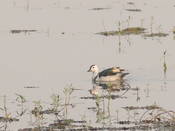search
classification
|
basic information
|
video
|
reports |
Cotton Pygmy-Goose
Nettapus coromandelianus (Gmelin, JF, 1789)

|

|
|
|
2012-06-18
Sonkul |
© Lars Edenius
|
|
Description
Small individuals of this species are the smallest waterfowl on earth, at as little as 160 g and 26 cm. The goose-like bill is short and deep at the base. Males have a dark brown forehead and crown and a blackish green broad collar at the base of the neck. The sides of the head and neck are whitish. The back, wing coverts and scapulars are dark brown with green and purple gloss. The female has a duller cap and a brown line through the eye. The collar is replaced by spots and the face is flecked and neck finely vermiculated unlike the male. The non-breeding or eclipse male resembles the female except that it has the broader white wing band. In flight the male has dark wings with white flight feathers tipped in black. The female has dark wings and a white trailing edge to the secondaries and a few inner primaries.
Distribution
One only record of Pygmy Cotton Goose in Kyrgyzstan and in whole territory of former Soviet Union was in Sonkul lake at June 18, 2012. Widely distributed in South Asia, its distribution extending to Australia. Population move in response to rain and water availability. Some populations disperse further in summer (and are found only seasonally, for instance in Afghanistan). Winter dispersal is also wide and individuals have been seen as far west as Arabia, and Jordan.
Biology
Breeding in monsoons time (in June-August in India). Biology in the Kyrgyz Republic is unknown. Status is vagrant bird.
References
Rasmussen, P.C.; Anderton, J.C. (2005). Birds of South Asia: They Ripley Guide. Volume 2. Smithsonian Institution and Lynx Edicions.

